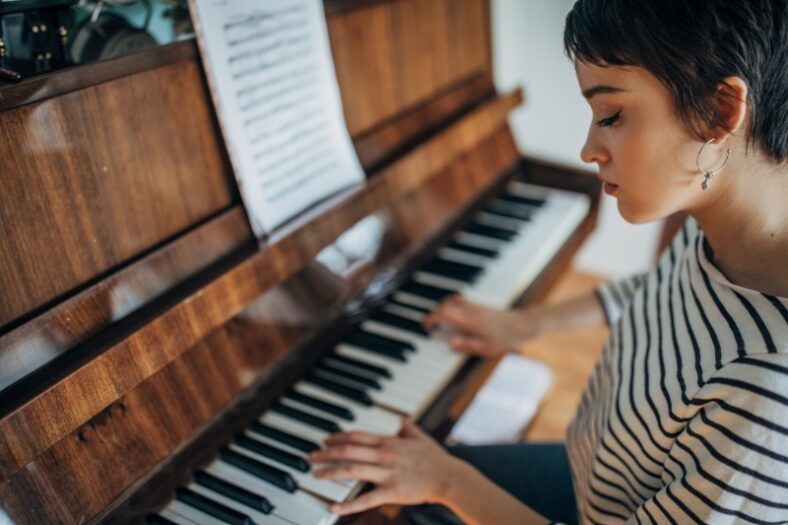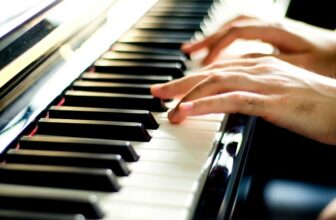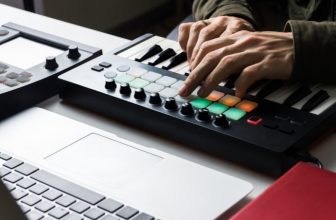7 Things A Beginner Pianist Should Practice

When you start playing an instrument, it is common to feel overwhelmed about what to learn and practice at first. If you have just started playing piano, you should build a solid foundation by learning fundamental techniques such as scales, chords, arpeggios, and more.
The piano is a beautiful and straightforward instrument to start your musical journey, and there are great exercises to keep you on track. There are 7 important topics to cover, which can help you learn faster and guide you throughout your track to becoming a good pianist.
Contents
1. Five Finger Scales
Also called the “Penta Scales,” five-finger scales are one of the most basic piano fundamentals. Before moving on to the full octave scales, it is essential to learn the Penta scales, consisting of five notes, with one for each finger.
Engraving the five finger scales and finger positions in your muscle memory will help you significantly when playing a song. When you can comfortably remember the 5 most important notes and the hand shape on a full scale, your hands and ears will go to the right notes easily, and you will experience a significant improvement in your playing.
There are 24 major and minor scales in total. So, practice and play slowly with each Penta scale to train your hands and ears. Start with major and minor keys and try to hear the tones carefully.
2. Chords
Chords are the hearts of any song. So, knowing the chords by heart is very important if you want to play piano well. You can start practicing basic major and minor 3-note chords. Try to memorize the chord shapes and notes of each chord.
If you want to play an A minor chord, you need the A, C, and E notes. The thumb will play the first note, the middle finger will play the C note, and the pinky will go to the E note. This is the hand shape you will use for all of the 3-note major and minor chords.
And later, you can add more notes to your chords, playing 4 or 5-note chords. Play the chords with your left hand, which can give the freedom to your right hand to play the melody.
3. Arpeggios
When familiar with the chords, you can practice some arpeggio patterns. An arpeggio indicates a broken chord, which means a chord played with a single note at a time. You can play them in descending or ascending order as you like.
Arpeggios are used all the time in classical music or popular music. So, it is important to be able to play them comfortably. Depending on how they are played, they make the music flowy, beautiful, or even energetic.
Start by finding the first note of a chord and play it with your thumb. The second finger will play the second note of the chord, and the third finger will go to the third note. The last note to play is the octave of the first note, which you should play with the fifth finger. For a C major arpeggio, you will play C, E, G, and C notes one note at a time.
4. Chord Progressions
After you feel comfortable, you can move on to creating some chord progressions. This way, you can practice changing between chords, which you will use very often when playing a song, as chord progressions give a sense of structure or direction to a piece of music.
There are endless possibilities to create chord progressions, but there are some rules to build them. So, you will have to learn the music theory of chords, tension, release movements, and chord functions in major and minor keys to create your progressions. Therefore, it is best to use an instructional video to see and play some already-described chord progressions as you learn the depths of chord progressions.
5. Left and Right Hand Coordination
Any beginner piano player should practice playing both chords and single notes equally well with both hands. You should build independence and strength for both hands and all fingers to be able to play with both hands simultaneously to create proper music with the piano.
To improve your hand coordination, you can play some daily exercises and basic songs that require both hand engagement. For example, playing a scale with the left hand in ascending order while simultaneously playing the same scale in ascending order with the right hand is a great exercise.
6. Songs
While exercises and theoretical knowledge are crucial for learning to play piano, the goal is to play songs. To stay motivated and keep track of your improvement, you should try and learn new songs occasionally. Fortunately, there are many beginner songs you can learn to play and have fun with.
You can choose some music you love to listen to and try to learn them. You can look for simpler versions or another song if they are too complicated. The piano should be something you enjoy, and playing songs is the best way to get there.
7. Properly Use Finger Placement
Finger positions are key when learning to play the piano well and quickly. To avoid injury, progress quicker, play at higher tempos, and make difficult music easier, you must build a solid foundation with your finger placement.
Most piano sheet music will have finger numbers to show which fingers to use. The number 1 indicates the thumb, the number 2 means the index finger, the number 3 is the middle finger, and the numbers 4 and 5 are the ring and pinky fingers, respectively. The numbers are inverted for both hands. So, try to stay loyal to the finger positions to build a solid technique when playing.
Conclusion
As with any instrument, the first steps are crucial when learning to play the piano. Try to take it slowly and remember that quality comes before quantity. Practice the techniques well and go with concrete steps before jumping to complex pieces or building up speed, sacrificing the technique.
To avoid having bad habits and techniques, which would be harder to change later, gradually build a good technique, which will get you to your goal quicker than any other way.





